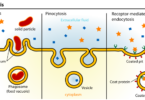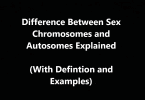Cytoplasm and cytosol are both parts of a cell. They make up the cell and are involved in many cell functions such as shape determination. The Difference between Cytoplasm and Cytosol is not pronounced since cytosol is the aqueous portion in the cytoplasm.
Cytoplasm: Definition and Functions.
The cytoplasm is all the material that is in a cell. This material is surrounded by the cell membrane. Everything except the nucleus is considered part of the cytoplasm as the internal components of the nucleus form the nucleoplasm. The cytosol is the major component of the cytoplasm so there isn’t exactly much Difference between Cytoplasm and Cytosol.
Other than that cytosol, organelles are present in the cell along with the cytoplasmic inclusion. The cytoplasm is colorless and it is mainly composed of water, up to 80%.
Many cellular activities take place in the cytoplasm. The important metabolic pathways of a cell such as glycolysis and cell division take place in the cytoplasm. These activities are regulated by the movement of calcium ions through the calcium channels in the cell. The cytoplasm is divided into two regions; the inner endoplasm which is concentrated and the outer ectoplasm.
The flow of cytoplasm is important for the permeability of the cytoplasm but it is still unknown how all the components interact with each other and maintain the cell structure. Major organelles of the cell such as mitochondria, endoplasmic reticulum, Golgi apparatus, and vacuoles are present in the cytoplasm.
The flow of cytoplasm is important for permeability of the cytoplasm but it is still unknown how all the components interact with each other and maintain the cell structure. Major organelles of the cell such as mitochondria, endoplasmic reticulum, Golgi apparatus and vacuoles are present in the cytoplasm.
Cytosol: Definition and Functions.
As mentioned earlier, there is no major Difference between Cytoplasm and Cytosol since cytosol is actually the aqueous component of the cytoplasm. Cytosol refers to that portion of the cytoplasm which is not contained within the organelles. Most of the cell volume, up to 70%, is composed of the cytosol.
This portion contains water, small molecules, filaments, and the cytoskeleton. There are protein filaments such as those made up of actin and tubulin. Other than that, small structures including vault complexes, ribosomes, and proteasomes are also present in the cytosol.
Cytosol is also sometimes called cytoplasmic matrix and its proportion varies in different cells. In bacterial cells, it makes up most of the cell structure while in plant cells, vacuole takes up most of the space. Small ions and metabolites are also present in the cytosol and they regulate cellular processes.
Summary of Difference Between Cytoplasm and Cytosol:
- The cytoplasm is the name given to everything enclosed by the cell membrane, except the nucleus.
- The cytosol is the aqueous portion of the cytoplasm which contains ions, small proteins, ribosomes, metabolites, and water.
- Everything present in the cytoplasm except the membrane-bound organelles makes up the cytosol.
- The main Difference between Cytoplasm and Cytosol is that cytoplasm contains organelles while cytosol does not.
- Cellular processes take place inside the cytoplasm, nucleus, and membrane-bound organelles.







Leave a Comment
You must be logged in to post a comment.